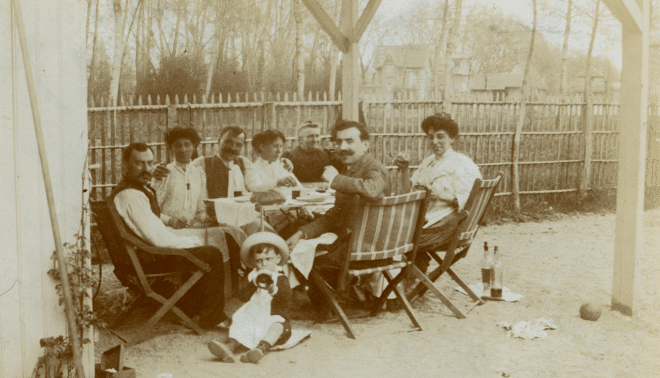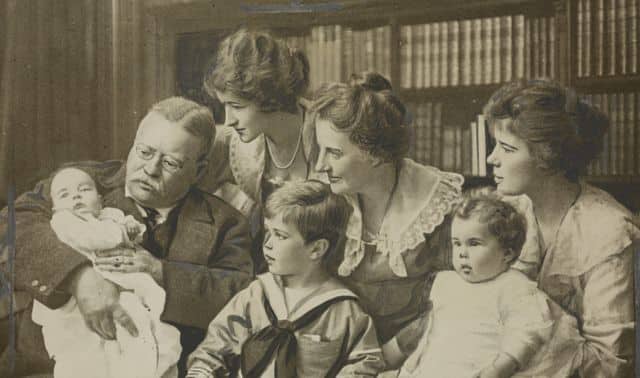Sign up for the Family Tree Newsletter Plus, you’ll receive our 10 Essential Genealogy Research Forms PDF as a special thank you!
Get Your Free Genealogy Forms
"*" indicates required fields
 Remember the good old days when you could buy a loaf of bread and a gallon of milk for less than a dollar? I’m sure you’ll agree that every year prices seem to rise while wages barely keep up. Though genealogy is a healthy and relaxing hobby, we all know indulging that interest takes a back seat to paying the bills.
Remember the good old days when you could buy a loaf of bread and a gallon of milk for less than a dollar? I’m sure you’ll agree that every year prices seem to rise while wages barely keep up. Though genealogy is a healthy and relaxing hobby, we all know indulging that interest takes a back seat to paying the bills.1. Go to the library.
Genealogists have plenty of reasons to visit libraries. Many mid-sized public institutions offer genealogy or local history collections, which could include maps, city directories, county and family histories, periodicals and basic genealogy how-to books. Your local library also might have a sizable microfilm collection, containing census, vital, military and other records. If it doesn’t have the sources you need, you can request them through interlibrary loan — ask your librarian for details.
Some libraries also subscribe to data-rich Web resources such as HeritageQuest Online <www.heritagequestonline.com> and Ancestry Library Edition (a libraries-only version of Ancestry.com <Ancestry.com >), which patrons can access on site for free.
Don’t forget college and university libraries. You don’t have to be a student to use these facilities, which have stacks full of genealogy and history books, periodicals and microfilms. Call ahead to find out when staff and computer terminals will most likely be available.
2. Seek complimentary consultations.
Have boxes full of unidentified images and don’t know where to turn? Take advantage of my Photo Detective columns on the Family Tree Magazine Web site, where I research a readers’ picture puzzles. (Note that I can’t analyze every picture I receive.)
3. Build your own library.
Here’s a creative way to add to your home library without breaking your budget: Write book reviews for a local genealogy journal or newsletter. In most cases, your payment will be the book itself. Contact a genealogical society near you to find out how you can contribute content.
To get your work accepted, be sure to review books that relate to the publication’s area of interest, stay within the word count set by the editor and check your grammar and punctuation. Also ask for the publication’s writer’s guidelines. If you’ve penned articles for other publications, send the editor a short letter of introduction with a writing sample. Consult Writer’s Digest <www.writersdigest.com> for tips on pleasing an editor.
4. Visit a neighborhood Family History Center.
Salt Lake City’s Family History Library (FHL) <www.familysearch.org> — the world’s largest genealogy research facility — might seem light years away, but you can access many of its resources by visiting a branch Family History Center (FHC) in your neighborhood. To search for an FHC near you, go to Family Search and click on the Library tab, then on Family History Centers. You also can search the FHL catalog online. Once you find a microfilm of interest, order a copy ($3 to $4 per roll) through your FHC to use there.
5. Surf free Web sites.
Sure, subscription sites such as Ancestry.com can speed your ancestor search, but don’t overlook the thousands of free family history sites — including FamilySearch, RootsWeb <www.rootsweb.com> and USGenWeb <www.usgenweb.org> — where you can search record transcriptions and connect with other genealogists. Cyndi’s List <www.cyndislist.com> will point you to 240,000 digital destinations. Check Family Tree Magazine‘s annual 101 Best Web Sites, too. Public libraries, historical societies and state archives have started putting research guides and collections information online. Several, including the Alabama Department of Archives & History <www.archives.state.al.us>, Library of Virginia <www.lva.lib.va.us> and Missouri State Archives <www.sos.mo.gov/archives>, offer free record databases.
6. Request a lookup.
In search of the Hatfield Family History or Czech Immigration Passenger Lists, covering 1870 to 1880? Dedicated genealogists from the Books We Own <www.rootsweb.com/ ~bwo> network will look up your family in these sources and hundreds of others for free. To find out what resources are available, scroll down to the master index and browse the collection, or enter a keyword into the search box. Once you find a book that interests you, follow the directions to request a lookup. You’ll receive an e-mail or snail mail reply. Volunteers ask only that you reimburse them for the cost of copies and postage.
7. Get news gratis.
Stay up-to-date on the genealogy world by subscribing to a free e-mail newsletter. Each edition of Family Tree Magazine‘s E-mail Update features Web-exclusive content covering family history trends, new resources and advice from genealogy experts.
Other popular genealogy newsletters include Eastman’s Online Genealogy Newsletter <www.eogn.com> (now in blog format) and RootsWeb Review.
It never hurts to ask if anyone’s found your great-aunt Mildred’s marriage record or extended your Perry line further back than five generations — and you can do so by posting to genealogy message boards such as those on Ancestry.com, Genealogy.com and RootsWeb. In addition, send notices to genealogical societies’ newsletters and even the newspapers in small towns where your ancestors lived (your queries might appear in the Letters to the Editor section). Make your request as specific as possible: Be sure to provide your ancestor’s full name, explain what information you seek, and give a brief account of what you know and where you’ve found those details. See other queries for examples of what works.
9. Obtain charts online.
You never have to buy a genealogical research form. You can get pedigree charts, family group sheets and specialized worksheets for free online. Type free pedigree charts into a search engine such as Google <www.google.com>, and you’ll find lots of options. Or visit our Free Forms area to download dozens of different forms and worksheets. You can make extra copies as you need them.
10. Practice good record-keeping.
How many times have you requested a copy of a record only to discover that you already had it? You can avoid this common — and costly — mistake by keeping careful research notes and organizing your paperwork. Need help? Consult Sharon DeBartolo Carmack’s Organizing Your Family History Search (Betterway Books).
11. Take advantage of free demos and downloads.
Haven’t committed to a genealogy software program yet? A few companies offer full-featured programs for free. Check out Legacy Family Tree Standard Edition <www.legacyfamilytree.com> and Personal Ancestral File <www.familysearch.org>.
Most other genealogy software makers offer free trial versions, which may have time limitations or disabled features — but will let you see whether they’re right for you. In general, look for downloads that don’t require a credit card number; otherwise, you might be charged when your trial period ends.
You can download all sorts of free programs from the Internet: photo organizers and editors, information managers and other odds and ends. Search for freeware and shareware (which you can use at no or low cost) on Download.com <www.download.com> and Shareware.com <www.shareware.com>.
12. Join a genealogical society.
The annual cost of society membership is usually a bargain, especially if you plan to use the organization’s resources often. For instance, a Research Membership to the New England Historic Genealogical Society (NEHGS) <www.newenglandancestors.org> costs $75 a year, and NEHGS charges $15 per day for nonmembers to use its research library. If you join NEHGS and visit the library once a month, you’ll be spending just $6 each visit — a considerable savings. You’ll also get online resources, a quarterly magazine and discounts on publications. Local societies offer plenty of benefits, too.
13. Maximize your spending.
Before signing up for multiple society memberships or online subscriptions, know what you’re getting. Always shop around to get the best deal — and to ensure you’re not signing up twice for access to the same tools.
For instance, membership in the New York Genealogical & Biographical Society <www.newyorkfamilyhistory.org>, which costs $60 per year, gives you access to ProQuest’s <www.proquest.com> Historical Newspapers New York Times database. Membership to the Connecticut-based Godfrey Memorial Library <www.godfrey.org> costs $35 per year and gets you access to the same database. Carefully weigh the costs and benefits of each membership so you end up buying only what you really need. Don’t subscribe to two services that offer the same perks unless you can’t live without the fringe benefits (journals or circulating materials, for instance).
The same goes for Ancestry.com and Genealogy.com, many of whose databases overlap. Sign up for one subscription (say, Ancestry.com’s US membership) and then add another as your research warrants. Ancestry.com offers free 14-day trials, but read the fine print: If you don’t cancel before the trial’s up, your credit card will be billed. Both sites automatically renew subscriptions, so be proactive and don’t get charged for something you no longer want.
Also keep in mind that with Web-site subscriptions, you’re paying for convenience. If you buy the subscription for only one or two databases, consider whether the potential gains are worth the expense. It might cost you less to track down the records at the library, or to hire a professional researcher to retrieve a document for you (contact the Association of Professional Genealogists <www.apgen.org> to find one in your area of interest).
14. Self-publish or perish.
If you want to preserve your family’s story in a book, on-demand printing usually is cheaper than short-run publishing, which requires you to commit to a certain number of copies. Look into print-on-demand services such as Bookpublisher.com <www.bookpublisher.com>, or print the work yourself and have it bound at a copy shop. Printing costs vary by book length, paper type, number of copies, cover style and binding methods. Ask for samples and a quote before you commit.
15. Build a low- or no-cost home on the Web.
Can’t afford to publish your family history on paper? Save money — and reach a wider audience — by building a genealogy Web site. Free Web hosting services abound. Some even offer complimentary site-building tools so you won’t have to learn HTML. See if your Internet Service Provider (ISP) offers free Web space, or find hosting services by searching <www.freewebspace.net>.
Most genealogy software can create Web pages from your GEDCOM files (the universal family tree file format). To illustrate your site, scan heritage photos or look for free clip art (do a Google search for “free clip art”).
Also consider creating a Web log (“blog” for short), an online journal you can use to chronicle your search and connect with distant cousins. Popular blog hosts include Blogger <www.blogger.com> and WordPress <www.wordpress.com>.
16. Acquire invaluable knowledge at seminars.
17. Go for the group rate.
When it comes to research trips, you’ll find savings in numbers. Join up with a group bound for Salt Lake City or another genealogy hub, and save big on accommodations, transportation and other expenses. Find out if an organization in your area is planning a trip, or suggest one.
18. Get discounts on tourist staples.
Before buying a modern map of your ancestors’ hometown, write to the chamber of commerce or tourist agency there to request free guidebooks and local maps. Enclose a self-addressed stamped manila envelope with your request, or e-mail the agency for specifics. AAA member benefits also include free or low-cost maps.
19. Go digital.
Cameras come in handy for more than just capturing family functions; you also can use them to photograph documents, heirlooms and old portraits. If you snap pictures frequently, consider buying a digital camera, a spare battery pack and an extra-large memory card. After the initial investment, digital photography is virtually free. You’ll certainly save on film, processing and photocopying fees. And if you use a free photo-sharing application, such as Hello <hello.com> or ShareALot <www.sharealot.com>, you won’t even need stamps to swap pics with relatives.
20. Make low-cost copies.
Here’s another way to trim expenses electronically: Cut back on paper copies. On your next research outing, carry your digital camera and take pictures of records and book pages instead of racking up photocopier fees. You’ll want to ask in advance if the facility permits photography, of course. But some repositories actually prefer this to patrons’ manhandling historical records.
You might not even need your camera. Both the FHL in Salt Lake City and NEHGS library in Boston have CD burners that patrons can use to make digital copies of documents on microfilm and microfiche. Patrons supply their own CDs, burn documents onto the discs and then take them home. (Note that you’re not allowed to copy an entire microfilm reel.) Once you copy the documents onto your own computer, you can improve their clarity using photo-editing software.
21. Key in book bargains.
Several institutions, including the Library of Congress (LOC), the University of Michigan and Cornell University, are posting books, journals and other materials from their collections online for free.
The LOC’s American Memory Web site <memory.loc.gov> serves up manuscripts, audio recordings, motion pictures, photographic prints, maps, sheet music and more.
Cornell University and the University of Michigan have teamed up to create Making of America (online at <library8.library.comell.edu/moa> and <www.hti.umich.edu/m/moagrp>), a digital library of 19th-century books and journals covering “American social history from the antebellum period through reconstruction.” The sites even hold a few published genealogies.
A new resource from search powerhouse Google <www.google.com> promises to radically expand your online access to books. Google Books lets you comb the contents of digitized tomes as you search the Web, then view images of the scanned book pages. The best part for genealogists: Google has teamed up with The New York Public Library, Harvard, Stanford, the University of Michigan and the University of Oxford to scan their libraries’ collections and integrate them into Google Books — which potentially could bring thousands of rare and out-of-print books directly to your desktop.
22. Never pay full price.
This basic shopping rule applies to genealogy, too. Scout out bookstores’ discount sections, and buy used copies at Amazon.com <www.amazon.com> and Barnes&Noble.com <www.bn.com>. You also might stumble upon a good deal at the auction site eBay <www.ebay.com>. Check office-supply stores’ ads for sales on research binders and folders, then buy in bulk to cut your per-item cost. When you shop for electronics — such as computers, printers, scanners, digital cameras and accessories — hunt for products that offer manufacturer rebates. (You’ll find especially good deals and discounts at the end of the year, when retailers are trying to entice holiday shoppers.)
23. Save on vital stats.
The next time you order copies of your ancestors’ vital records, ask for uncertified copies (available only in some states). These cost considerably less than certified ones. For example, you’ll pay $10 for a certified death record from the Johnston County, NC, Register of Deeds office — but just 10 cents for an uncertified copy.
24. Join a mailing list.
You can get gratis family history advice from people who share your research interests by subscribing to a free e-mail list. To find an appropriate one, search the Mailing Lists category on Cyndi’s List. Joining is as simple as sending an e-mail. Once you’ve signed up, you can start sending queries to fellow list members. Be forewarned, though: Some lists are quite active and might clog your inbox.
25. Divide and conquer.
Why work on a family history project alone? Ask your relatives to help out. Splitting costs and sharing the workload can help you save time and money, and reconnect with kin.
26. Lend a hand.
In this era of shrinking budgets, nonprofit organizations are struggling to maintain services and operating hours. Setting aside a few hours a week or month to help out does more than support the overworked staff at these facilities. Each time you assist a patron, you’ll gain an insider’s knowledge of the collections. Plus, you’ll meet other local genealogists and maybe even make a few friends.
On your next library or archive visit, ask about volunteer opportunities. Historical societies, museums, genealogical groups and the National Archives’ <www.archives.gov> regional facilities all use volunteers — and will be grateful for your help.
ADVERTISEMENT






